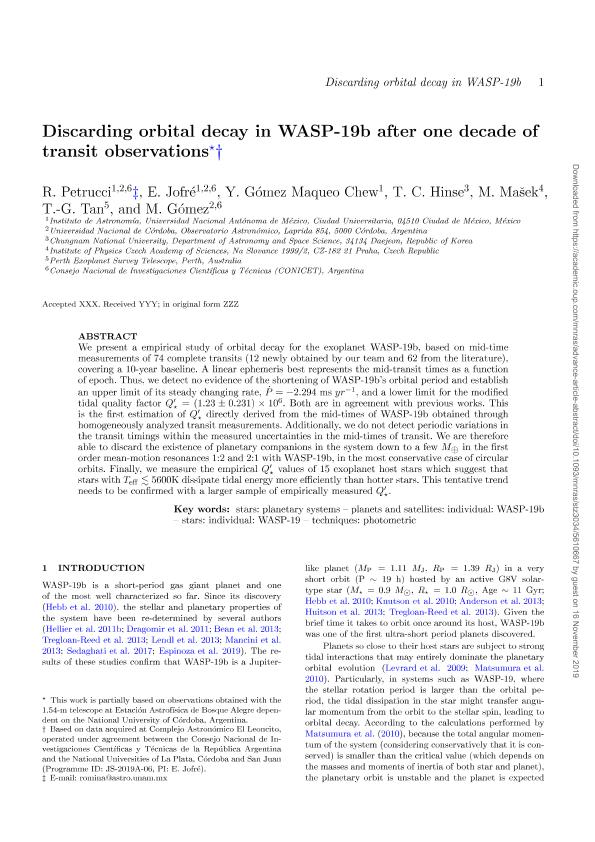Artículo
Discarding orbital decay in WASP-19b after one decade of transit observations
Petrucci, Romina Paola ; Jofre, Jorge Emiliano
; Jofre, Jorge Emiliano ; Gómez Maqueo Chew, Y.; Hinse, T. C.; Mazek, M.; Tan, T. -G.; Gomez, Mercedes Nieves
; Gómez Maqueo Chew, Y.; Hinse, T. C.; Mazek, M.; Tan, T. -G.; Gomez, Mercedes Nieves
 ; Jofre, Jorge Emiliano
; Jofre, Jorge Emiliano ; Gómez Maqueo Chew, Y.; Hinse, T. C.; Mazek, M.; Tan, T. -G.; Gomez, Mercedes Nieves
; Gómez Maqueo Chew, Y.; Hinse, T. C.; Mazek, M.; Tan, T. -G.; Gomez, Mercedes Nieves
Fecha de publicación:
10/2019
Editorial:
Wiley Blackwell Publishing, Inc
Revista:
Monthly Notices of the Royal Astronomical Society
ISSN:
0035-8711
e-ISSN:
1365-2966
Idioma:
Inglés
Tipo de recurso:
Artículo publicado
Clasificación temática:
Resumen
We present an empirical study of orbital decay for the exoplanet WASP-19b, based on mid-time measurements of 74 complete transits (12 newly obtained by our team and 62 from the literature), covering a 10-yr baseline. A linear ephemeris best represents the mid-transit times as a function of epoch. Thus, we detect no evidence of the shortening of WASP-19b's orbital period and establish an upper limit of its steady changing rate, P' = −2.294 ms yr−1, and a lower limit for the modified tidal quality factor Q'* = (1.23 ± 0.231) × 106. Both are in agreement with previous works. This is the first estimation of Q' directly derived from the mid-times of WASP-19b obtained through homogeneously analysed transit measurements. Additionally, we do not detect periodic variations in the transit timings within the measured uncertainties in the mid-times of transit. We are therefore able to discard the existence of planetary companions in the system down to a few M in the first-order mean-motion resonances 1:2 and 2:1 with WASP-19b, in the most conservative case of circular orbits. Finally, we measure the empirical Q'* values of 15 exoplanet host stars, which suggest that stars with Teff ≲ 5600 K dissipate tidal energy more efficiently than hotter stars. This tentative trend needs to be confirmed with a larger sample of empirically measured Q'*.
Archivos asociados
Licencia
Identificadores
Colecciones
Articulos(CCT - CORDOBA)
Articulos de CTRO.CIENTIFICO TECNOL.CONICET - CORDOBA
Articulos de CTRO.CIENTIFICO TECNOL.CONICET - CORDOBA
Citación
Petrucci, Romina Paola; Jofre, Jorge Emiliano; Gómez Maqueo Chew, Y.; Hinse, T. C.; Mazek, M.; et al.; Discarding orbital decay in WASP-19b after one decade of transit observations; Wiley Blackwell Publishing, Inc; Monthly Notices of the Royal Astronomical Society; 491; 1; 10-2019; 1243-1259
Compartir
Altmétricas



